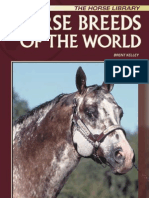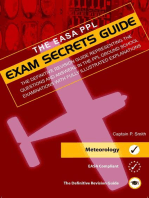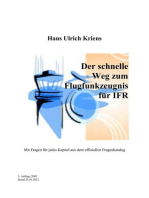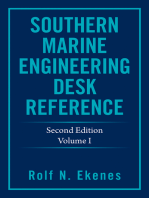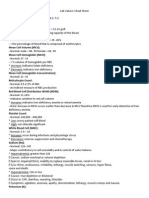Class 14: Drag Prediction II: Parasite Drag - "Drag Build-Up"
Uploaded by
Krish ManglaniClass 14: Drag Prediction II: Parasite Drag - "Drag Build-Up"
Uploaded by
Krish ManglaniA&AE 251 Class 14 9/27/02
Class 14: Drag Prediction II
K Parasite
drag - drag build-up
Flat plate equivalent area Complete MD-80 example
K Parasite
drag due to lift drag
Induced drag coefficient
K Compressibility
Drag divergence mach number Wing sweep
K Predicting
total drag
Total Parasite Drag
K With
all information, use build-up to estimate parasite drag
CD p =
components
KiQi C f i S weti S ref
D p = C D p qS
A&AE 251 Class 14 9/27/02
Flat Plate Equivalent Area
KA
means to compare drag of different aircraft
f e = C D p S ref
fe =
Dp q
MD-80 Drag - Wing
C (CD )w = K wQwS f
p w
S wet w
K Parasite
ref
drag coefficient
( f e )w = C D p Sref
( )w
K Flat
plate equivalent area
A&AE 251 Class 14 9/27/02
MD-80 Drag - Fuselage
C (CD ) f = K f Q f S f
p f
S wet f
K Parasite
ref
drag coefficient
( f e ) f = CD p Sref
( )f
K Flat
plate equivalent area
MD-80 Parasite Drag Build-up
Component Wing Fuselage Horizontal Tail Vertical Tail Nacelles Pylons Total fe [ft2] CDp
2.16 0.61 1.54 0.35
0.00170 0.00048 0.00121 0.00028
A&AE 251 Class 14 9/27/02
MD-80 Drag - Miscellaneous
K MD-80
n n n
aircraft
Flight conditions
V = 750 ft/s M = 0.76 h = 32,000 ft Re/l = 2.0254106 ft-1 = 8.270410-4 sl/ft3 a = 986.22 ft/s
Atmosphere
n n n
K Miscellaneous
drag
coefficient, CDmisc
K Parasite
drag coefficient, CDp
Parasite Drag Due to Lift
K Experimentally,
CDp varies with CL2
2
CL 2 CD = CD p + kCL + + CDmisc AR
K Terms
k and combined into Oswald Efficiency Factor, e
CL2 CD = CD p + + C Dmisc ARe
generally, 0.75 < e < 0.85
A&AE 251 Class 14 9/27/02
MD-80 Drag - Induced Drag
K
Weight and geometry
W = 140,000 lb S = 1270 ft2 AR = 9.62 e = 0.8 (estimated)
Flight conditions
V = 750 ft/s = 0.76 h = 32,000 ft = 8.270410-4 sl/ft3 a = 986.22 ft/s
Lift coefficient, CL
Induced drag coefficient, CDi
10
Compressibility Drag
K Factor
in transonic (and faster) flight regime
Flow passing a body can be locally supersonic Supersonic bubble forms on airfoils
A&AE 251 Class 14 9/27/02
11
Drag Divergence Mach Number
K Compressibility
(CD )c
drag becomes significant, at drag divergence mach number (MDD)
airfoils
0.035 0.03 0.025 0.02 0.015 0.01 0.005
jet transports fly below aircrafts MDD
0 0 0.5 1 1.5
12
Wing Sweep
KA
means to increase MDD of the wing K Sweep angle, c/4
c/4
MT
simple estimator for wing MDD
M0
MN
(M DD )swept wing =
(M DD )airfoil
cos c 4
A&AE 251 Class 14 9/27/02
Compressibility Drag Design Issues
13
Boeing 777 cruise M = 0.83
Concorde cruise M = 2.04
K Difficult
to predict CDc (methods beyond 251) K Select airfoil and sweep
speed required additional complexity and weight
K Jet
passenger transports fly M MDD
MD-80 Drag - Compressibility Drag
K
14
Geometry
= 24.5 wing t/c = 0.11
Flight conditions
V = 750 ft/s M = 0.76 h = 32,000 ft = 8.270410-4 sl/ft3 a = 986.22 ft/s
K
Compressibility drag coefficient, CDc
Estimated wing MDD
A&AE 251 Class 14 9/27/02
15
Predicting Total Drag
K Total
drag coefficient C D = C D p + C Di + C Dmisc + C Dc
KiQi C f i S weti S ref CL2 + + C Dmisc + C Dc ARe
CD =
i
You might also like
- The ENDLESS WEB - Fascial Anatomy & Physical Reality - Shultz & Feitis100% (11)The ENDLESS WEB - Fascial Anatomy & Physical Reality - Shultz & Feitis132 pages
- TL 1.15 Example Aircraft Loading CalculationsNo ratings yetTL 1.15 Example Aircraft Loading Calculations22 pages
- Design Project On Reincarnation of Concorde: Anna University: Chennai 600 025No ratings yetDesign Project On Reincarnation of Concorde: Anna University: Chennai 600 02567 pages
- Kelley - Horse Breeds of The World - 0791066525100% (5)Kelley - Horse Breeds of The World - 079106652565 pages
- Nalini Singh - Weapons Training (Guild Hunter #2.5)No ratings yetNalini Singh - Weapons Training (Guild Hunter #2.5)10 pages
- Pressure Points-Vital Points and Weak Points of The Human Anatomy100% (2)Pressure Points-Vital Points and Weak Points of The Human Anatomy1 page
- Configuration Aerodynamics: Lift CoefficientNo ratings yetConfiguration Aerodynamics: Lift Coefficient13 pages
- Wing Planform and Tail Sizing: Altitude and Weight ScalingNo ratings yetWing Planform and Tail Sizing: Altitude and Weight Scaling10 pages
- Data Collection and Preliminary Three-View Drawing - 2 TopicNo ratings yetData Collection and Preliminary Three-View Drawing - 2 Topic15 pages
- +++++++ESTIMATING RC MODEL AERODYNAMICS AND PERFORMANCE-RC Airplane DesignNo ratings yet+++++++ESTIMATING RC MODEL AERODYNAMICS AND PERFORMANCE-RC Airplane Design13 pages
- Design of Unmanned Aerial Combat VehicleNo ratings yetDesign of Unmanned Aerial Combat Vehicle70 pages
- Estimating RC Model Aerodynamics and PerformanceNo ratings yetEstimating RC Model Aerodynamics and Performance11 pages
- Cross-Checks On Design of Tail Surfaces - 2 Topics: Airplane Design (Aerodynamic) Prof. E.G. Tulapurkara Chapter-9No ratings yetCross-Checks On Design of Tail Surfaces - 2 Topics: Airplane Design (Aerodynamic) Prof. E.G. Tulapurkara Chapter-97 pages
- Flight Performance Requirements: Range and EnduranceNo ratings yetFlight Performance Requirements: Range and Endurance14 pages
- AE19402 - Aircraft Performance - Question BankNo ratings yetAE19402 - Aircraft Performance - Question Bank6 pages
- Presentation: Aircraft Route Optimization For Formation FlightNo ratings yetPresentation: Aircraft Route Optimization For Formation Flight95 pages
- Exercises: Flight Dynamics-I Prof. E.G. Tulapurkara Chapter-6No ratings yetExercises: Flight Dynamics-I Prof. E.G. Tulapurkara Chapter-62 pages
- Introduction To Aerospace Engineering: Lecture SlidesNo ratings yetIntroduction To Aerospace Engineering: Lecture Slides56 pages
- -α plot?: 2 do 2 do 2 do prop 2 do 2 do propNo ratings yet-α plot?: 2 do 2 do 2 do prop 2 do 2 do prop2 pages
- Thrust - at - V - 500 8.2272e+03: Root - 681.2747 681.2747 - 234.6362 234.6362No ratings yetThrust - at - V - 500 8.2272e+03: Root - 681.2747 681.2747 - 234.6362 234.63622 pages
- Flight Mechanics: 1 Two-Dimensional AirfoilsNo ratings yetFlight Mechanics: 1 Two-Dimensional Airfoils4 pages
- Estimation of Wing Loading and Thrust Loading-2 TopicsNo ratings yetEstimation of Wing Loading and Thrust Loading-2 Topics15 pages
- Transition From Considerations of Performance To Stability & ControlNo ratings yetTransition From Considerations of Performance To Stability & Control25 pages
- Small Unmanned Fixed-wing Aircraft Design: A Practical ApproachFrom EverandSmall Unmanned Fixed-wing Aircraft Design: A Practical ApproachNo ratings yet
- Southern Marine Engineering Desk Reference: Second Edition Volume IFrom EverandSouthern Marine Engineering Desk Reference: Second Edition Volume INo ratings yet
- Aviation Weather: FAA Advisory Circular (AC) 00-6B (Blackridge Press FAA Series)From EverandAviation Weather: FAA Advisory Circular (AC) 00-6B (Blackridge Press FAA Series)No ratings yet
- Aeronautical Chart Users Guide: National Aeronautical Navigation ServicesFrom EverandAeronautical Chart Users Guide: National Aeronautical Navigation Services3/5 (1)
- Miscellany 51: Apparent Wind Speed and True Wind SpeedFrom EverandMiscellany 51: Apparent Wind Speed and True Wind SpeedNo ratings yet
- Babysitters Erotica Collection Over 100 Green Vallen67% (3)Babysitters Erotica Collection Over 100 Green Vallen890 pages
- A Town Sliding Into Hell! A Town Sliding Into Hell!100% (3)A Town Sliding Into Hell! A Town Sliding Into Hell!34 pages
- Crude Analysis For Sulphur Distribution in DieselNo ratings yetCrude Analysis For Sulphur Distribution in Diesel5 pages
- Experiment 132: Determination of The Viscosity Coefficient of A Liquid and The Temperature-Viscosity DependenceNo ratings yetExperiment 132: Determination of The Viscosity Coefficient of A Liquid and The Temperature-Viscosity Dependence3 pages
- Experimental Investigation On Thermal Properties of Silver Nanofluids-1No ratings yetExperimental Investigation On Thermal Properties of Silver Nanofluids-111 pages
- Instruction For Steam Boilers Preservation During Shut Down PeriodNo ratings yetInstruction For Steam Boilers Preservation During Shut Down Period2 pages
- Hydraulic Loss - Waterway - Penstock - PLTM Kambangan 27.08.2020No ratings yetHydraulic Loss - Waterway - Penstock - PLTM Kambangan 27.08.20201 page
- Flow Visualization of Footballs To Analyze The Factors Affecting Their Aerodynamic Performance Using CFD100% (1)Flow Visualization of Footballs To Analyze The Factors Affecting Their Aerodynamic Performance Using CFD16 pages
- GEAR 300 75W-90 en DE Motul 34200 20221014No ratings yetGEAR 300 75W-90 en DE Motul 34200 202210142 pages
- Ansys Fluent Project in Advanced Fluid MechanicsNo ratings yetAnsys Fluent Project in Advanced Fluid Mechanics28 pages
- Back To Basics - Pump Specific Speed and Suction Specific Speed - WaterWorldNo ratings yetBack To Basics - Pump Specific Speed and Suction Specific Speed - WaterWorld7 pages
- Couette Flow Analytical and Numerical Solution100% (1)Couette Flow Analytical and Numerical Solution4 pages
- The ENDLESS WEB - Fascial Anatomy & Physical Reality - Shultz & FeitisThe ENDLESS WEB - Fascial Anatomy & Physical Reality - Shultz & Feitis
- Design Project On Reincarnation of Concorde: Anna University: Chennai 600 025Design Project On Reincarnation of Concorde: Anna University: Chennai 600 025
- Nalini Singh - Weapons Training (Guild Hunter #2.5)Nalini Singh - Weapons Training (Guild Hunter #2.5)
- Pressure Points-Vital Points and Weak Points of The Human AnatomyPressure Points-Vital Points and Weak Points of The Human Anatomy
- Wing Planform and Tail Sizing: Altitude and Weight ScalingWing Planform and Tail Sizing: Altitude and Weight Scaling
- Data Collection and Preliminary Three-View Drawing - 2 TopicData Collection and Preliminary Three-View Drawing - 2 Topic
- +++++++ESTIMATING RC MODEL AERODYNAMICS AND PERFORMANCE-RC Airplane Design+++++++ESTIMATING RC MODEL AERODYNAMICS AND PERFORMANCE-RC Airplane Design
- Cross-Checks On Design of Tail Surfaces - 2 Topics: Airplane Design (Aerodynamic) Prof. E.G. Tulapurkara Chapter-9Cross-Checks On Design of Tail Surfaces - 2 Topics: Airplane Design (Aerodynamic) Prof. E.G. Tulapurkara Chapter-9
- Flight Performance Requirements: Range and EnduranceFlight Performance Requirements: Range and Endurance
- Presentation: Aircraft Route Optimization For Formation FlightPresentation: Aircraft Route Optimization For Formation Flight
- Exercises: Flight Dynamics-I Prof. E.G. Tulapurkara Chapter-6Exercises: Flight Dynamics-I Prof. E.G. Tulapurkara Chapter-6
- Introduction To Aerospace Engineering: Lecture SlidesIntroduction To Aerospace Engineering: Lecture Slides
- Thrust - at - V - 500 8.2272e+03: Root - 681.2747 681.2747 - 234.6362 234.6362Thrust - at - V - 500 8.2272e+03: Root - 681.2747 681.2747 - 234.6362 234.6362
- Estimation of Wing Loading and Thrust Loading-2 TopicsEstimation of Wing Loading and Thrust Loading-2 Topics
- Transition From Considerations of Performance To Stability & ControlTransition From Considerations of Performance To Stability & Control
- Small Unmanned Fixed-wing Aircraft Design: A Practical ApproachFrom EverandSmall Unmanned Fixed-wing Aircraft Design: A Practical Approach
- Der schnelle Weg zum Flugfunkzeugnis für IFRFrom EverandDer schnelle Weg zum Flugfunkzeugnis für IFR
- Southern Marine Engineering Desk Reference: Second Edition Volume IFrom EverandSouthern Marine Engineering Desk Reference: Second Edition Volume I
- Aviation - Theorico-Practical text-book for studentsFrom EverandAviation - Theorico-Practical text-book for students
- Aviation Weather: FAA Advisory Circular (AC) 00-6B (Blackridge Press FAA Series)From EverandAviation Weather: FAA Advisory Circular (AC) 00-6B (Blackridge Press FAA Series)
- Aeronautical Chart Users Guide: National Aeronautical Navigation ServicesFrom EverandAeronautical Chart Users Guide: National Aeronautical Navigation Services
- Miscellany 51: Apparent Wind Speed and True Wind SpeedFrom EverandMiscellany 51: Apparent Wind Speed and True Wind Speed
- Babysitters Erotica Collection Over 100 Green VallenBabysitters Erotica Collection Over 100 Green Vallen
- A Town Sliding Into Hell! A Town Sliding Into Hell!A Town Sliding Into Hell! A Town Sliding Into Hell!
- Experiment 132: Determination of The Viscosity Coefficient of A Liquid and The Temperature-Viscosity DependenceExperiment 132: Determination of The Viscosity Coefficient of A Liquid and The Temperature-Viscosity Dependence
- Experimental Investigation On Thermal Properties of Silver Nanofluids-1Experimental Investigation On Thermal Properties of Silver Nanofluids-1
- Instruction For Steam Boilers Preservation During Shut Down PeriodInstruction For Steam Boilers Preservation During Shut Down Period
- Hydraulic Loss - Waterway - Penstock - PLTM Kambangan 27.08.2020Hydraulic Loss - Waterway - Penstock - PLTM Kambangan 27.08.2020
- Flow Visualization of Footballs To Analyze The Factors Affecting Their Aerodynamic Performance Using CFDFlow Visualization of Footballs To Analyze The Factors Affecting Their Aerodynamic Performance Using CFD
- Back To Basics - Pump Specific Speed and Suction Specific Speed - WaterWorldBack To Basics - Pump Specific Speed and Suction Specific Speed - WaterWorld



















